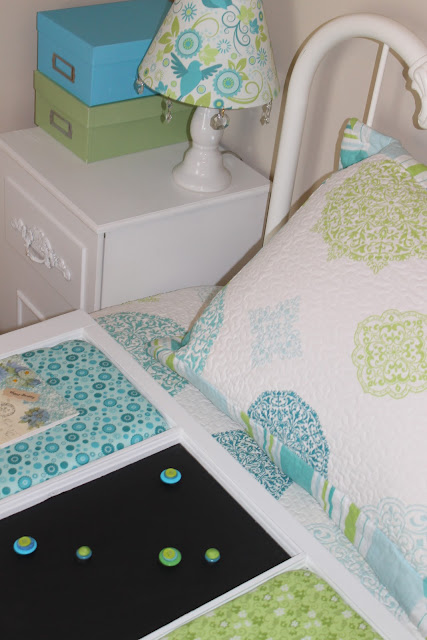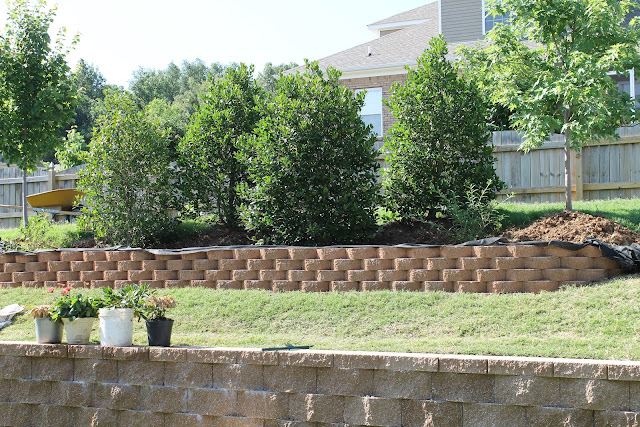Let me begin by saying that this was our summer project. We started in middle May thinking that it would still be cool. Unfortunately, with this season's high temperatures, we did not escape the heat.
When we first moved into the house, there was a retaining wall built into the hillside. On this hillside, included was a planting of 6 trees. Here is the before picture:
The backyard always looked messy. I never liked the look of the middle 4 trees. It never seemed to be balanced.
I had planted some peonies, forsythia and iris' in the bed. It was so unsightly and too steep of an incline to hold soil and mulch. Mr. Thrifty came up with the idea to add yet add another smaller retaining wall.
Of course,
we were going to do this project ourselves. Heavy sigh. I'm getting too old for this! So, for the next two weekends, he dug a trench to start the first course of brick, which must be buried.
We made 3 trips to Lowe's for the building block, pea gravel and river rock.
The first step was to measure using a measuring tape, string and a garden hose. We laid the hose out first to see if we liked the shape. Then, we pulled out a opened can of white spray paint and painted over the hose leaving our line of demarcation. Since it was an old hose, it didn't matter that the hose became rather sticky from the paint.
This next picture shows the gentle curve up into the hillside.
You can barely see the white line of paint.
After measuring, Mr. Thrifty used a flat edge shovel to cut through the sod. It didn't take long before he realized that he needed his work boots to cut through the clay with the shovel. I think he looks much cuter with the boots on.
I might interject here that even though you can't see me in the pictures, I am helping. I left the digging to him, but I was out there supporting him in any way I could getting supplies and lending a hand.
He cut through 8 inches of soil.
The first course of brick needs to be below ground level. Since the brick's depth was 6 inches, we had to level yet another 2 inches of pea gravel below the brick for the initial placement. This is what it looked like with the pea gravel balanced inch by inch with a level.
Here is a closer look at the two strings, the lower one for pea gravel, and the top one for the top of the brick.
Once it was cut 8 inches deep, he strung two lines of string down the trough. The first string measured 2 inches up for the pea gravel had to sit. The second higher string had to follow the top of the first brick laid in on top of the pea gravel
This shows the first course laid.
A very important point to be made is that on the first course only, remove the ridge underneath each brick to make it level. This ridge can be removed with a hammer and chisel. I could even do this part. Here is a picture of the bottom of the block with the ridge.
Every other added course needs the ridge to lock onto as you build up the levels.
Notice how each brick on the first course has to be leveled so it settles perfectly into the pea gravel.
This step is very time consuming but is worth all the work, because each additional level will just have to be placed one on top of another without the level.
Notice the top of the string is level with the top of the brick.
Now it was time to cut up into the slope.
A 25 foot sheet of black weed preventer was laid down under and behind the back of the brick.
As a side bar, when we lived in Little Rock, we realized quickly why it was called such. Every time you would dig into the clay, you would find little rocks. This place should be called Big Rock. Here are some of the boulders we have literally extracted out of the hillside. I have shown a house brick to compare their sizes.
I love to watch the TV show called IF WALLS COULD TALK. People purchase older homes and excavate unbelievable treasures. Well, we found something....
A very aged shuttlecock???? No treasures on this plot of land. Maybe next time.
Now it was time to add the second course. Other than carrying the brick, this was the easiest step so far. This course is offset. This will be easier to see in the 3rd course.
Make sure to lock each brick with the ridge on the underside with the previous row of the lower block.
Here is the 3rd and starting of the 4th course. Notice the pattern of the brick.
Here is a picture of the brick being built into the hillside
This is the final course of brick. We will be adding a cap brick when finished.
Standing back looking at the new wall, I realize how badly the trees looked in their formation. 3rd weekend, here we come. The moving of the trees.
Now, we needed to stabilize the wall. Mr. Thrifty pulled a sheet of plywood out of the garage. He placed it behind the new brick halfway to the soil line. While I held the board, he scooped in river rock on the immediate backside of the rock. On the other side of the board, he pushed and stomped soil. This is how it looks looking down at the board.
Then the board was removed and the soil and river rock settled into place.
So I would have more room for my perennials, I wanted to take one tree completely out of the formation, move two other trees back to make an arc on the hill. The third weekend was taken up with digging up and moving the trees. Once again, the clay got the best of us(or should I say, Mr. Thrifty). He purchased an even larger pick axe. We worked like archeologists, carefully cleaning each rootball so as to not traumatize them before moving to other spots.
The last tree had to be moved up to the top of the hill. Two 2x4's were used as fulcrums and the Mr. pulled his car jack out of the garage. I didn't get a picture of this, because I was sitting on one of the 2x4's as he was jacking it up. The girls got into the fray too. Once he raised the jack, the little one would take my spot on the 2x4 and I would help the Mr. and our first daughter heave it up a few inches. Oh my goodness, that was one of the worst jobs we have ever attempted.
However, once it was done, it looked like this. Mind you this is two days worth of work since the last picture.
Once the trees were moved, we needed to level the bed. Before, the mulch would run off because of the hill being so steep. Now we shoveled all that dirt back into the hill. The perennials are ready to plant. I still have 21 bags of topsoil, 2 bags of manure and 1 large bag of soil conditioner to finish out leveling the hilltop bed.
We still have 2 very small birch trees that were given to us to plant. Mr. Thrifty named them after the girls. I am going to plant them on opposite ends of the 3 holly trees. I think the arc of trees will be a nice barrier between the neighbor's yard and ours.
I'm taking a break here. Off to Illinois and Wisconsin for the family wedding.
On the next blog, see the job that Mr. Thrifty completed on the backyard while I was away. He works too hard!


















































